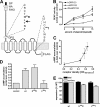Cell adhesion receptor GPR133 couples to Gs protein
- PMID: 22025619
- PMCID: PMC3234928
- DOI: 10.1074/jbc.C111.265934
Cell adhesion receptor GPR133 couples to Gs protein
Abstract
Adhesion G protein-coupled receptors (GPCR), with their very large and complex N termini, are thought to participate in cell-cell and cell-matrix interactions and appear to be highly relevant in several developmental processes. Their intracellular signaling is still poorly understood. Here we demonstrate that GPR133, a member of the adhesion GPCR subfamily, activates the G(s) protein/adenylyl cyclase pathway. The presence of the N terminus and the cleavage at the GPCR proteolysis site are not required for G protein signaling. G(s) protein coupling was verified by Gα(s) knockdown with siRNA, overexpression of Gα(s), co-expression of the chimeric Gq(s4) protein that routes GPR133 activity to the phospholipase C/inositol phosphate pathway, and missense mutation within the transmembrane domain that abolished receptor activity without changing cell surface expression. It is likely that not only GPR133 but also other adhesion GPCR signal via classical receptor/G protein-interaction.
Figures


References
-
- Yona S., Lin H. H., Siu W. O., Gordon S., Stacey M. (2008) Trends Biochem. Sci. 33, 491–500 - PubMed
-
- Yona S., Lin H. H., Dri P., Davies J. Q., Hayhoe R. P., Lewis S. M., Heinsbroek S. E., Brown K. A., Perretti M., Hamann J., Treacher D. F., Gordon S., Stacey M. (2008) FASEB J. 22, 741–751 - PubMed
-
- Veninga H., Becker S., Hoek R. M., Wobus M., Wandel E., van der Kaa J., van der Valk M., de Vos A. F., Haase H., Owens B., van der Poll T., van Lier R. A., Verbeek J. S., Aust G., Hamann J. (2008) J. Immunol. 181, 6574–6583 - PubMed
Publication types
MeSH terms
Substances
LinkOut - more resources
Full Text Sources
Other Literature Sources
Molecular Biology Databases

